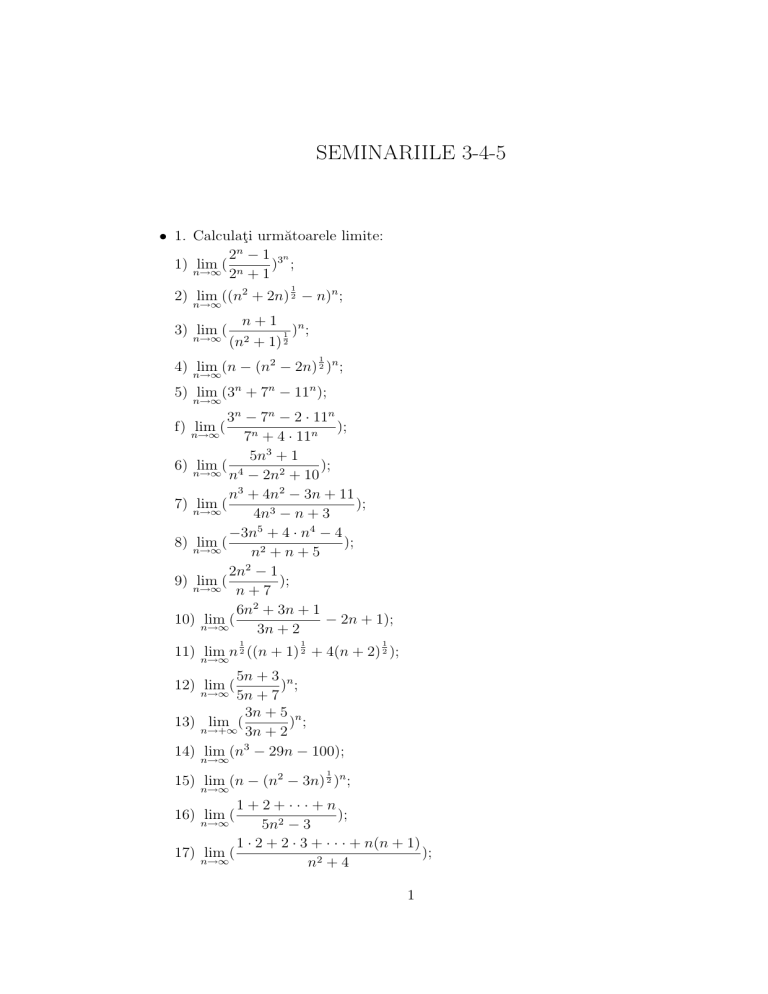
SEMINARIILE 3-4-5
• 1. Calculaţi următoarele limite:
2n − 1 3n
1) lim ( n
) ;
n→∞ 2 + 1
1
2) lim ((n2 + 2n) 2 − n)n ;
n→∞
3) n→∞
lim (
n+1
(n2
+ 1)
1
2
)n ;
1
4) lim (n − (n2 − 2n) 2 )n ;
n→∞
5) lim (3n + 7n − 11n );
n→∞
3n − 7n − 2 · 11n
);
n→∞
7n + 4 · 11n
5n3 + 1
6) lim ( 4
);
n→∞ n − 2n2 + 10
n3 + 4n2 − 3n + 11
7) n→∞
lim (
);
4n3 − n + 3
−3n5 + 4 · n4 − 4
8) n→∞
lim (
);
n2 + n + 5
2n2 − 1
9) lim (
);
n→∞ n + 7
6n2 + 3n + 1
10) n→∞
lim (
− 2n + 1);
3n + 2
f) lim (
1
1
1
11) n→∞
lim n 2 ((n + 1) 2 + 4(n + 2) 2 );
5n + 3 n
) ;
5n + 7
3n + 5 n
) ;
13) lim (
n→+∞ 3n + 2
14) lim (n3 − 29n − 100);
12) lim (
n→∞
n→∞
1
15) lim (n − (n2 − 3n) 2 )n ;
n→∞
1+2+···+n
);
n→∞
5n2 − 3
1 · 2 + 2 · 3 + · · · + n(n + 1)
);
17) lim (
n→∞
n2 + 4
16) lim (
1
1
18) lim (1 + x) x ;
x→0
x2 + 1
;
x&1 (x − 1)2
19) lim
2x2 − 5x + 2
;
x→2 x2 − 6x + 8
3x2 + 14x − 5
lim 2
;
x→−5 2x + 12x + 10
x2 − x
lim
;
x→+∞ −x2 + 2x + 3
x+1
lim
;
x→3 |x − 3|
ax − 1
lim
, unde a > 1;
x→0
x
sin x
lim
;
x→+∞ x
lnx
lim
;
x→1 x − 1
4x3 − x2 + 1
lim
;
x→+∞ 2x3 + x − 2
2x
lim 2
;
x→+∞ x + 1
x2 − 5
lim
;
x→+∞ 5x4 − x3 + 20x2 − 1
x2 + 1
lim 3
;
x→0 x − 25x + 3
x6 − x5 − 2x2 + 45
lim
;
x→+∞
x2 + x + 1
x5 + x3 + x2 − 20
lim
;
x→−∞
x2 − x − 2
n+2 n
lim (
) ;
n→∞ (n2 + 4) 12
20) lim
21)
22)
23)
24)
25)
26)
27)
28)
29)
30)
31)
32)
33)
3n + (−3)n
;
n→∞
4n
3π
);
35) lim (n3 sin
n→0
3n + 7
x2 − 2x + 1
36) lim
;
x→−∞ 4x3 − 5x
34) lim
2
1
37) lim (5 − 2x) x−2 ;
x→2
sin(2x)
.
x→0
3x
38) lim
• 2. Stabiliţi natura următoarelor serii:
2 n
a) Σ+∞
n=0 ( 5 ) ;
n
n
2 +3
b) Σ+∞
n=0 2n+1 +3n+1 ;
2
n +2n
c) Σ+∞
n=0 n2 +3 ;
1
d) Σ+∞
n=1 sin n2 ;
1
e) Σ+∞
n=1 n(n+1) ;
2
n +3
f) Σ+∞
n=0 arcsin n2 +n+1 ;
2
n +n−1
g) Σ+∞
n=0 (n+1)! ;
2
n
h) Σ+∞
n=0 sn5 +4 ;
n
i) Σ+∞
n=0 2n ;
j) Σ+∞
n=0
1
1
1
(n+4) 2 +(n+2) 2
;
4
n
k) Σ+∞
n=0 n5 +(cos n)2 .
• 3. Calculaţi limitele laterale pentru următoarele funcţii ı̂n punctele indicate
(acolo unde are sens).
a) f : IR \ {−1, 1} → IR, f (x) =
b) f : IR \ {3} → IR, f (x) =
1
x2 −1
x
|x−3|
ı̂n x = −1 şi x = 1;
ı̂n x = 3;
c) f : (4, +∞) → IR, f (x) = ln(x − 4) ı̂n x = 4;
d) f : IR \ {2} → IR, f (x) =
x2 +7
(x−2)2
e) f : IR \ {0, 3} → IR, f (x) =
ı̂n x = −1 şi x = 1;
2
x2 (x−3)
ı̂n x = 0 şi x = 3;
f) f : IR \ {kπ; k ∈ Z} → IR, f (x) =
2
(sin x)5
ı̂n x = 0 şi x = π;
g) f : IR \ {kπ; k ∈ Z} → IR, f (x) =
1
(sin x)2
ı̂n x = 0.
• 4. Au următoarele funcţii limită ı̂n punctele indicate? Justificaţi.
a) f : IR → IR, f (x) = sin(2x) ı̂n x = +∞;
b) f : IR∗ → IR, f (x) = cos x3 ı̂n x = 0;
c) f : IR → IR, f (x) = x sin(2x) ı̂n x = 0;
d)
f :(0,4)∪(4,+∞)→IR, f (x)=x−7
x−4
ı̂n x = 4.
3
• 5. Studiaţi continuitatea funcţiilor ı̂n punctele indicate:
a)
b) f : IR → IR, f (x) =
x − 7,
(
c) f : IR → IR, f (x) =
(
d) f : IR → IR, f (x) =
5x − 9,
2x + 3,
x≤1
1 < x ≤ 6 , ı̂n x = 1 şi x = 6;
x>6
x,
2x − 7,
x<0
, ı̂n x = 0;
x≥0
4 − x,
x≤3
, ı̂n x = 3.
x>3
x2 −5x+6
,
x−3
4
